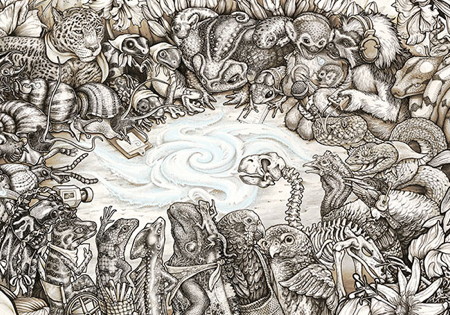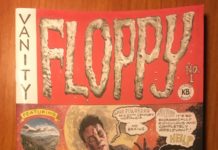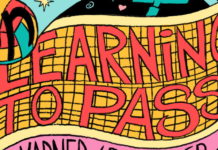
by Mary Kinney
This weekend marked the first annual Comic Arts Brooklyn (CAB) festival, presented by small Williamsburg comic book shop Desert Island. Because of this, perhaps, it felt like a neighborhood affair. Panels were held at the Brooklyn Knitting Factory and book sales and signings were a few blocks away, at Mt. Carmel church. It has effectively replaced the Brooklyn Comic Graphics Festival (BCGF)—also presented by Desert Island—which was less directed in theme and manifested itself in many artists bringing out their more adult content.The two panels I went to represented the spectrum of the festival, and all I saw were pretty well attended, too, which was exciting since this is technically the first festival. Panels varied from up-and-coming artists to more well established artists, both working to bring comic writers and artists together and into the conversation.
The first panel I attended was entitled “The New Generation: What We Like,” which featured Michael DeForge, Lisa Hanawalt, Joe Lambert and Katie Skelly speaking about inspiration and coming-of-age understandings of the comics medium. DeForge (who debuted his work Ant Colony at CAB) spoke about emailing arts collective Seripop (which features members of AIDS Wolf) essentially asking them what he should check out as a fan of Seripop. Their response, DeForge explained, shaped his interest in comics for the next few years. In a lot of ways, this panel offered to do the same thing: pass on enthusiasm to other comic readers and creators. All the panelists displayed an overarching love of dark, weird comics, speaking to bizarre inspirations—either in story content or in design—which mark the new wave of artists. A few of the panelists, in a sort of camaraderie, referenced other artists that had a table this year. In a bigger way, many of the tables at the festival itself reflected this push towards the strange, towards the dark. Yet, there is almost always a kind of playfulness about the work.
After this panel let out, Jeff Smith took the stage to offer insight into his creative process (the panel was appropriately called “Jeff Smith: Pulled Apart”). Smith is another artist that couples the somber with the funny, but he is an established star with multiple graphic novels and a following under his belt. Instead of doing a similar round-table to the “What We Like” panel, this interview gave audiences a better understanding of how professional comic artists might work. Jeff Smith showed—through what was essentially a high tech overhead projector—original drawings from Bone, bits of his outlines, pencil sketches from various projects, and never-before-seen work from Smith’s upcoming online (!) project, Tuki Save the Humans. It felt like a true privilege to see the process of an artist first hand: after showing examples of his process, Smith inked a drawing in a live demonstration while answering questions (as expected, the kids tended to ask the best questions).
Jeff Smith was one of the more successful artists on the bill, but this, too, was geared towards creators. Not only to better understand his method so one might better push forward as an artist, but the inking Jeff Smith completed live was auctioned off to benefit Comic Book Defense League (Smith is a board member for this organization).
Both of these panels really catered to the comic creator here—in a lot of ways, this felt like the goal of the festival overall: to bring together comics creators who are also fans.
Heading to Mt. Carmel Church after the Jeff Smith was a bit of a challenge. Both floors were incredibly crowded, making the dialogue between seller and buyer a little more stressful. There were fantastic finds to be had in spite of the crowds, and a number of familiar faces for those who do the regular convention rounds in NYC. To sweeten the pot: most of the works were extremely affordable.
The dark playfulness shined through in works like Heather Benjamin’s Delinquent and the black metal love story of Henry & Glenn Forever & Ever #3—with more absurd work coming from works like Joanna Avilez’s Poodle Potential, all of which debuted at CAB. There were also a good amount of comics working in non-standard formats: Thibaud Herem’s accordion book London Deco had its debut at CAB and the elaborate posters of The Beehive Collective were nothing short of breathtaking (I ended up buying one online because I couldn’t stop thinking of them after the fest).
After leaving Mt. Carmel, I headed to the Desert Island store, coming back to a more familiar setting. A handful of people were browsing, a record spinning on the player. Above one of the racks were original works by Charles Burns in a small exhibition Desert Island was hosting. The drawings looked like comic books in its plastic casings, displaying images of tragedy using purples, blues, and peach skin. The cover names appeared to be in a different language, but they were unseen Nitnit issues 1-10. The cashier at Desert Island said that Burns had been wanting to do an art exhibition like this for a while now. People were asking what were inside the books. Stories? More images? The cashier told us that Burns said they were blank. This was striking to me: his stories of this series were depicted—at least in segments—through cover art alone. Burns is asking us to connect those dots, perhaps. Giving us the wheel.
More than anything, CAB provided a promotion of dialogue and brotherhood within the comic community. That a small comic shop like Desert Island presented has a great amount to do with it: the fest was rooted in its own locality (many of the exhibitors were from the NYC area), and because of this, there was a certain closeness that radiated. CAB was a festival that embraced the strange—and, increasingly—the unknown.
[Mary Kinney is a person living in Brooklyn. She studies and writes about subcultures with an emphasis on independent publishing. She writes about music, comics, and feminism. You can keep up with her on Twitter here.]








It’s worth noting that BCGF was presented by Desert Island, Bill Kartalopoulos, and PictureBox (not just Desert Island).
Comments are closed.